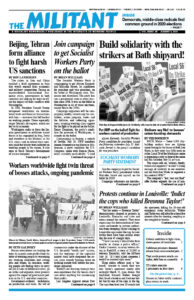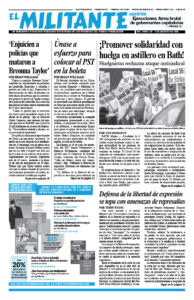SACRAMENTO, Calif. — Over 100 people drove past Gov. Gavin Newsom’s house and rallied in nearby Banister Park here July 5 to demand the state government respond to the increasingly dangerous conditions facing inmates in California’s prisons. Some 5,800 inmates have contracted COVID-19 in the state’s overcrowded prisons and 31 have died.
Similar conditions exist in state prisons and local jails across the country.
The disease has spread across the state as a result of the California Department of Corrections and Rehabilitation transferring infected inmates from prison to prison. On May 30, for instance, the department shipped 121 inmates from Chino prison, after an extensive outbreak there, to San Quentin, where no prisoner was known to have the disease. Today there are over 1,600 confirmed cases and seven deaths in the San Quentin prison.
For years California prisoners have fought to better conditions in the state’s institutions through hunger strikes, lawsuits and other protests. In 2006 medical care in the California prison system was placed into receivership after a federal court ruled that health care conditions were unconstitutionally inadequate.
In 2011 the U.S. Supreme Court ruled that California had to slash its overcrowded prison population by 33,000 because of the extreme suffering and even deaths it caused.
In 2013 over 28,000 California prisoners organized a hunger strike that forced the California Department of Corrections and Rehabilitation to curtail its use of solitary confinement.
A representative of the Prison Human Rights Movement, a group of prisoners who participated in the hunger strike, addressed the Sacramento rally by hookup. He said they were fighting for three demands: “Release all prisoners who are medically fragile and over 60; release all prisoners who have served 25 consecutive years in prison and are over 60; and release all prisoners who have only a few more months of their sentences left to serve.”
Dolores Gonzalez, a bus driver from San Jose whose husband Armando has been incarcerated at San Quentin for 18 years, told this Militant worker-correspondent at the rally that he and other prisoners weren’t getting adequate medical care.
In a phone interview afterwards, she read to me a letter Gonzalez wrote her June 23.
“There is no electrical power and no hot water. We can’t take showers and we can’t watch TV. We are kept in the cell pretty much 24/7. There is no sunlight and no fresh air,” he said. “The back light in my cell is full of insects. When I asked the CO to bring a bottle of disinfectant he said he would but never did.” San Quentin authorities are “deliberately indifferent and negligent,” he said.
On July 1, 20 San Quentin prisoners, all of whom tested positive for COVID-19, announced a hunger strike. Their demands include access to showers, fresh air and electrical power. They say medical care is inadequate and men deemed asymptomatic are forced to double up in a single small cell.
Under pressure from the protests, Gov. Newsom announced July 10 that he will release another 8,000 prisoners by the end of August, after having released 3,500 others a month earlier. Like the earlier releases, the state will only free inmates with a short time left on their sentence, or medical conditions that put them at high risk of getting coronavirus. Tens of thousands of prisoners like Armando Gonzalez, who was sentenced to life in prison, will not qualify.
And it would take releasing 20,000 inmates — at least 12,000 more than Newsom plans — to get down to what prison authorities admit is 100% of the state prison system’s capacity.
More protests are planned.

